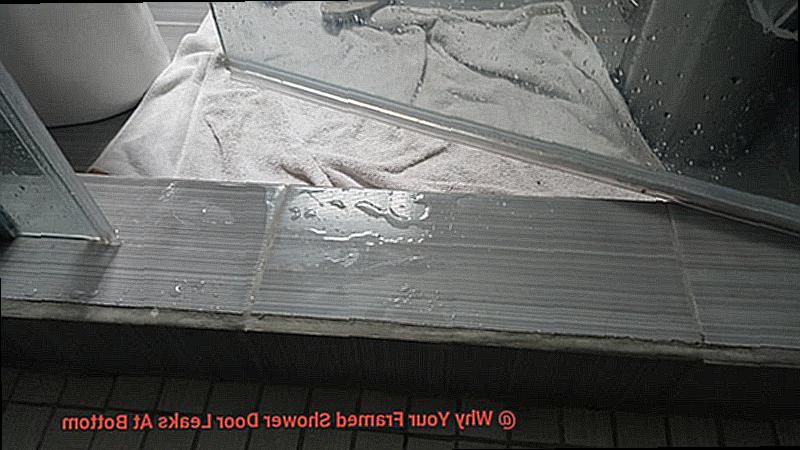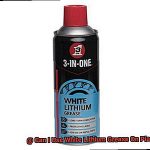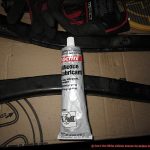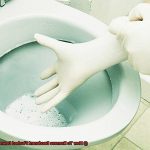Do you have a framed shower door that’s leaking at the bottom?
You’re not alone. This is a common problem that can be caused by many factors, from poor installation to aging seals.
In this blog post, we’ll explore why your framed shower door leaks at the bottom and what you can do about it. Have you ever stepped out of the shower only to find water on the floor outside of it?
It’s an annoying issue that can be caused by several conditions. A defective or improperly installed framed shower door is one of the most common culprits.
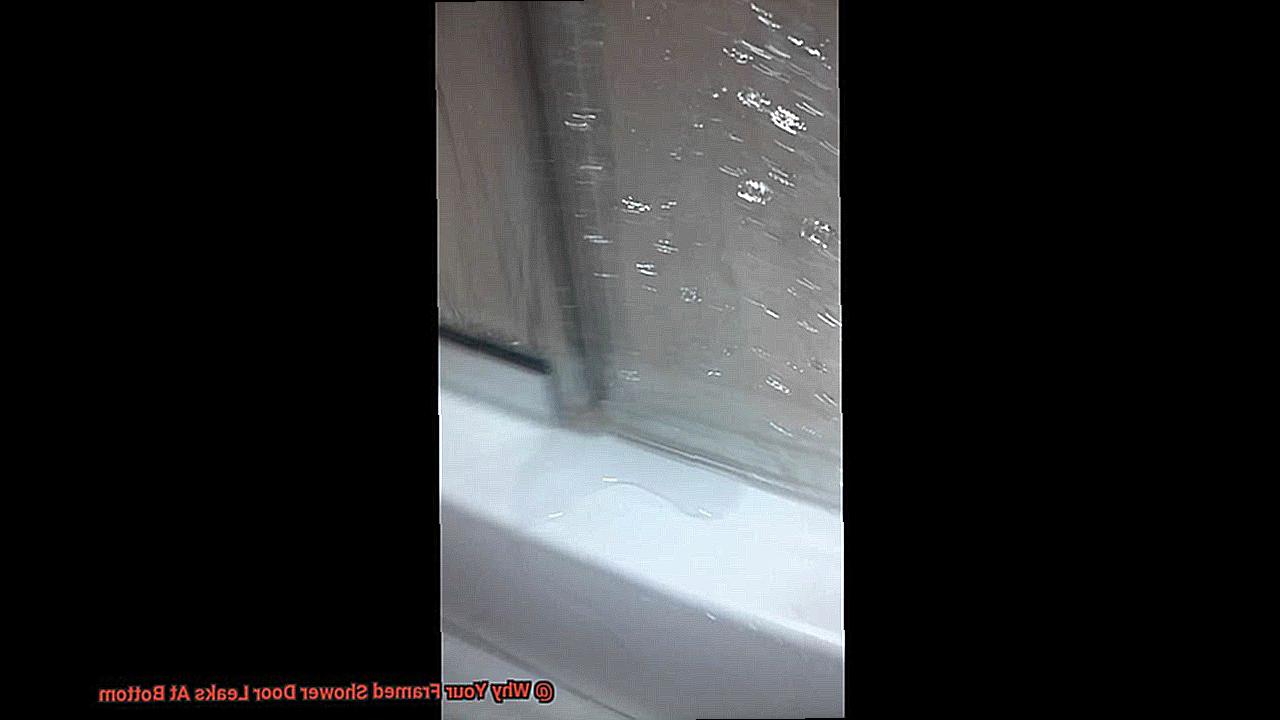
Framed shower doors are designed to keep water inside the shower area, but if they aren’t sealed properly or installed correctly, water can escape through any gaps in the frame. Metal frames tend to corrode over time, which can create gaps in the seal and allow water to leak out.
If your framed shower door isn’t attached securely to either the wall or floor, it won’t provide an effective seal and water will easily escape through cracks and gaps in the frame. In this blog post, we’ll discuss why your framed shower door leaks at the bottom and how you can prevent it from happening again.
We’ll also look at some potential solutions for existing leaks so that you can enjoy a clean bathroom once more.
Contents
- 1 Common Causes of Leaks at the Bottom of Framed Shower Doors
- 2 How to Fix a Leaking Hinge on a Framed Shower Door
- 3 Installing a Leak Guard on Your Framed Shower Door
- 4 Other Potential Causes of Leaks at the Bottom of Framed Shower Doors
- 5 How to Align Your Framed Shower Door Properly
- 6 Cleaning and Maintaining Your Framed Shower Door to Prevent Leaks
- 7 How to Repair Warped Frames on Your Framed Shower Door
- 8 How to Remove Hard Water Stains and Soap Scum Buildup from Your Shower Door
- 9 Conclusion
Common Causes of Leaks at the Bottom of Framed Shower Doors
Leaks at the bottom of a framed shower door can be a major issue for homeowners.
Not only can it lead to water loss and mold, but it’s also unsanitary. Fortunately, there are some steps you can take to identify and fix the problem.
One of the most common causes of leaks is worn-out seals. Over time, the rubber seals that line the bottom of framed shower doors can become hard and dry, making them less effective at preventing water from escaping.
If your shower door has been in place for a while, it’s worth checking to see if the seals are still working properly. Poor installation is another common cause of leaks.
If the shower door isn’t level or well-aligned, gaps may form between the frame and wall that allow water to escape. In addition, hinges that hold the shower door in place can become loose or damaged over time, which may also lead to water leakage.
Incorrectly sized shower doors are another potential source of leaking showers. If the door is too small for its opening, gaps may form between the frame and wall that allow water to escape.
If you want to keep your framed shower door leak-free, it’s important to identify any issues quickly and address them accordingly.
How to Fix a Leaking Hinge on a Framed Shower Door
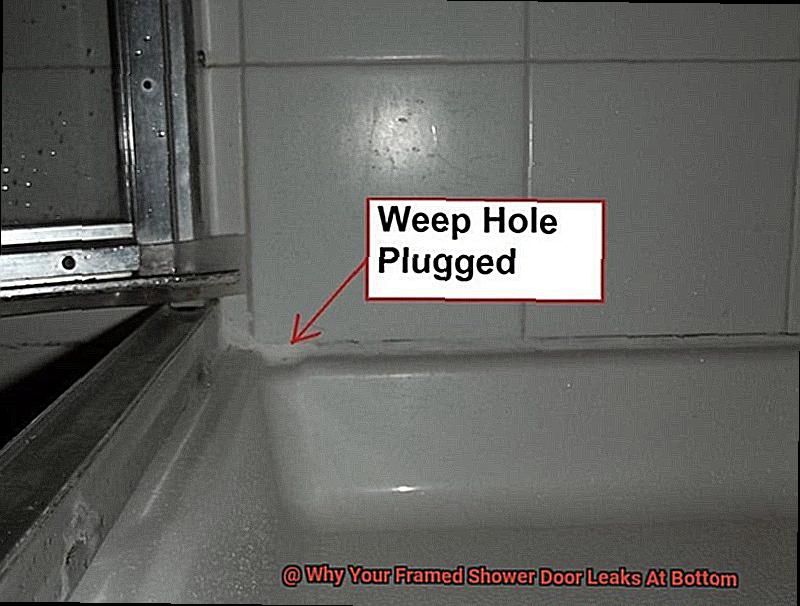
Many homeowners have experienced this problem, and it can be a nuisance. Fortunately, repairing a leaky hinge on a framed shower door is usually a quick and painless process that does not necessitate professional assistance. Here are five ways to restore your shower door to working order:
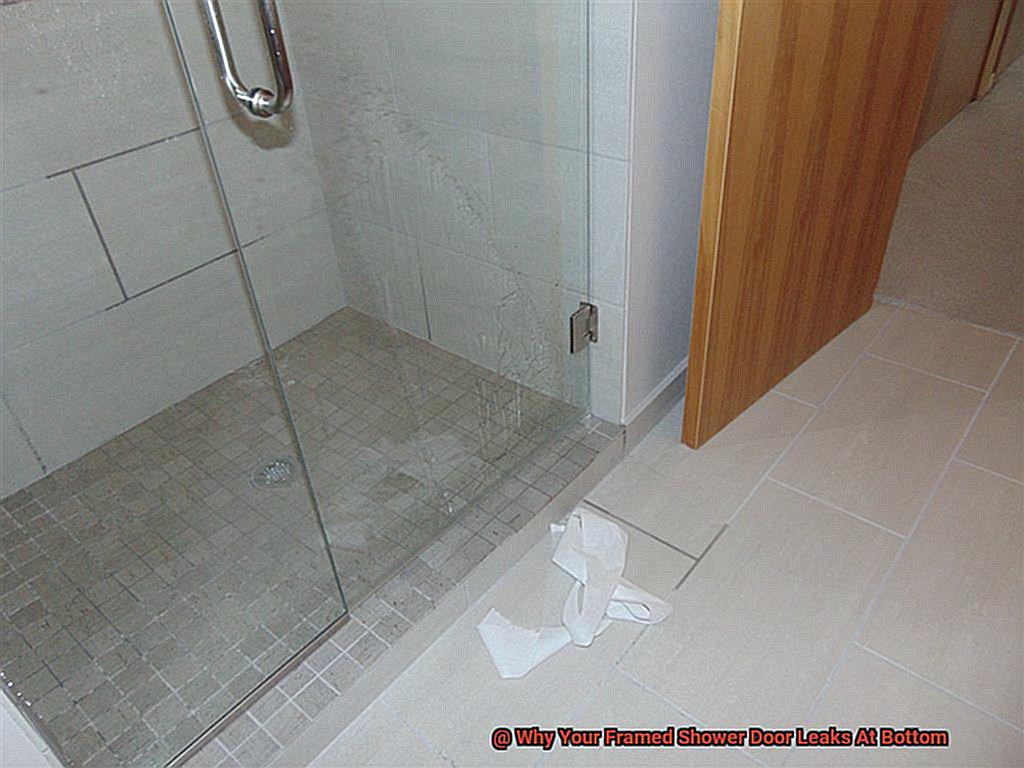
Check the Hinge
Ensure that the hinge itself is secure and tightly screwed into place. Loose screws can often cause leaks, allowing water to seep out from under the door. Tighten any loose screws with a screwdriver or replace them with new ones if necessary.
Inspect the Gasket
A gasket is a rubber or plastic seal that helps block water from passing through the gap between the door and the frame. Check for any cracks, holes, or displacement in the gasket and replace it if necessary.
Level the Door
In order to prevent water from pooling at the bottom of the door and causing leaks, verify that your shower door is level. Adjusting the slope of your shower base or installing a sweep gasket at the bottom of your door will help prevent future leaks from occurring.
Lubricate Moving Parts
To ensure that your door opens smoothly and no gaps appear between the seal and hinge when in use, apply silicone lubricant to all hinges and pivot points.
Replace Hinges
If all else fails, you may need to replace your hinges entirely with ones that are of the correct size and style for your shower door. In addition, it’s also recommended that you replace all hinges at once in order to avoid having to repeat this procedure again.
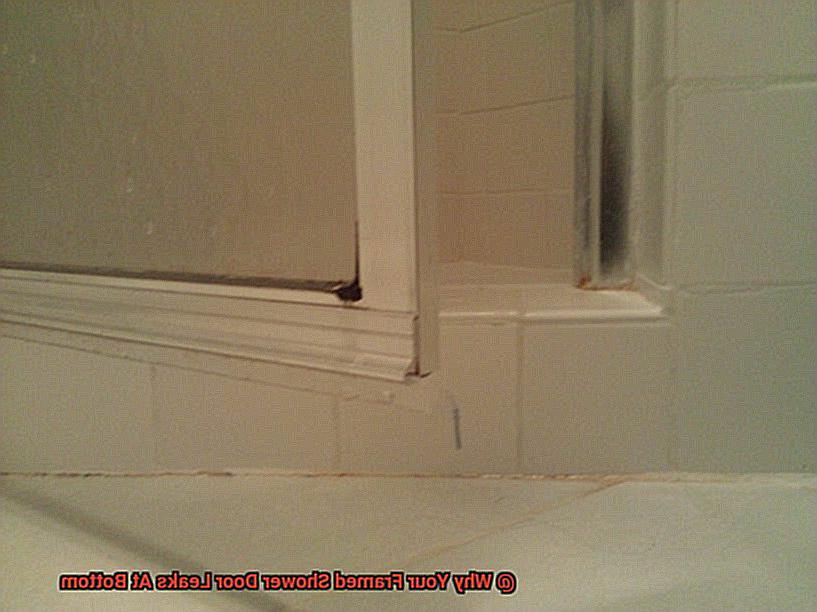
Fixing a leaky hinge on a framed shower door can be intimidating, but it doesn’t have to be.
Installing a Leak Guard on Your Framed Shower Door
Installing a leak guard can be the perfect solution.
A leak guard is a strip of plastic that attaches to the bottom edge of your shower door, creating a water barrier that prevents water from leaking onto your bathroom floor. It’s a simple and cost-effective way to ensure that your bathroom stays dry and free from mold growth.
To begin, make sure to clean the bottom edge of your shower door with a non-abrasive cleaner and let it dry completely. Measure the length of the door and cut the leak guard strip to fit using a hacksaw or similar tool.
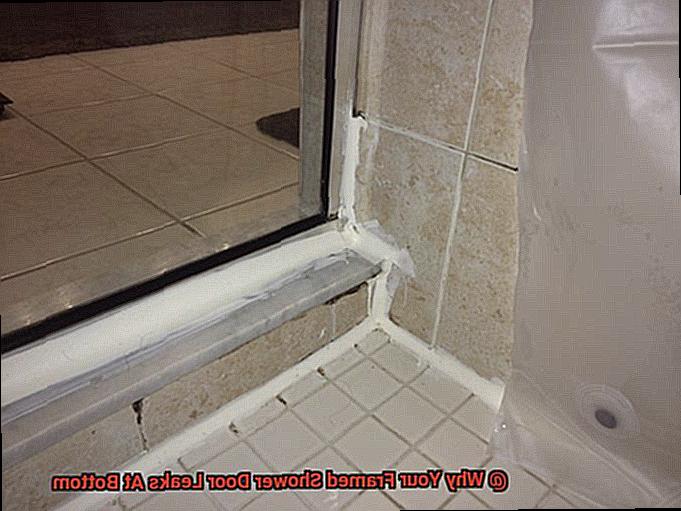
Then, remove the backing from the adhesive tape on the leak guard and firmly press it into place on the bottom edge of your shower door. This will guarantee that it creates an effective seal against water leakage.
It’s important to note that some shower doors may require different installation methods for their leak guards, so make sure you read any instructions provided by the manufacturer carefully. Additionally, if your shower door is still leaking after installing a leak guard, you may need to look into other solutions such as resealing or replacing worn-out seals.
Installing a leak guard on your framed shower door is an easy way to solve this common problem without having to call in an expert.
Other Potential Causes of Leaks at the Bottom of Framed Shower Doors
The culprit may be a leaky framed shower door.
This issue can be caused by several factors, from improper installation to damaged or worn-out components. Fortunately, there are some simple steps you can take to identify and address the problem.
The most likely cause is improper installation. This often means that the sweep or drip rail – a flexible strip of plastic attached to the bottom of the shower door which helps seal the gap between the door and shower pan – has been incorrectly installed or has become worn out over time, resulting in cracks and breaks that allow water to seep through.
Replacing or repairing this component should do the trick. A poorly designed shower pan, cracks or chips in either the door or pan itself could also be causing your leak.
To resolve these issues, it may be necessary to replace or upgrade your shower pan with one that is properly sloped. In any case, it’s important to fix any leaks as soon as possible to avoid further damage.
How to Align Your Framed Shower Door Properly
Having a well-aligned framed shower door is essential for keeping your bathroom clean and free from water damage. Leaks at the bottom of the door can cause slippery floors, mold growth, and other problems if not addressed. Here are five simple steps to help you properly align your framed shower door and keep it in good working condition:
Tighten Loose Screws
To ensure that the door frame is secure, check all screws and brackets for any loose connections. A loose screw or bracket can cause misalignment, resulting in water leakage.
Adjust Brackets
Most shower door brackets have slots that allow for easy adjustment. Use a wrench or screwdriver to loosen the brackets and slide the door up or down until it is level and plumb.
Adjust Hinges
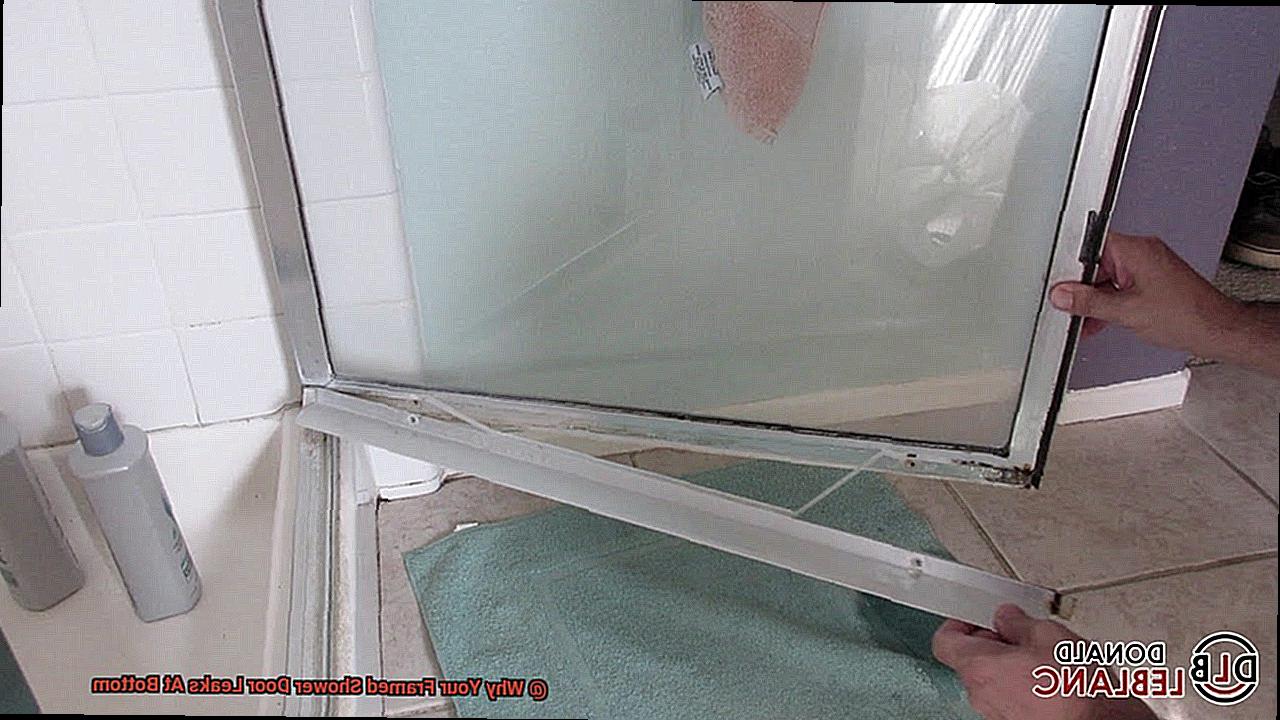
If water is leaking from the side closest to the hinge, try loosening the screws on the hinge and moving it up or down as needed to properly align the door.
Install a Drip Rail
Installing a drip rail on the bottom edge of your door helps direct water back into the shower and prevent it from leaking out onto your bathroom floor.
Replace Door if Necessary
In some cases, you may need to replace your shower door if it is too old or damaged. When replacing your shower door, call a professional to avoid damaging tiles or other elements in your bathroom.
Cleaning and Maintaining Your Framed Shower Door to Prevent Leaks
Having a framed shower door that’s clean and well-maintained can make all the difference in preventing leaks.
To ensure your door stays in top condition, follow these easy steps. First, use a mild soap and water solution to wash the frame and glass of your shower door.
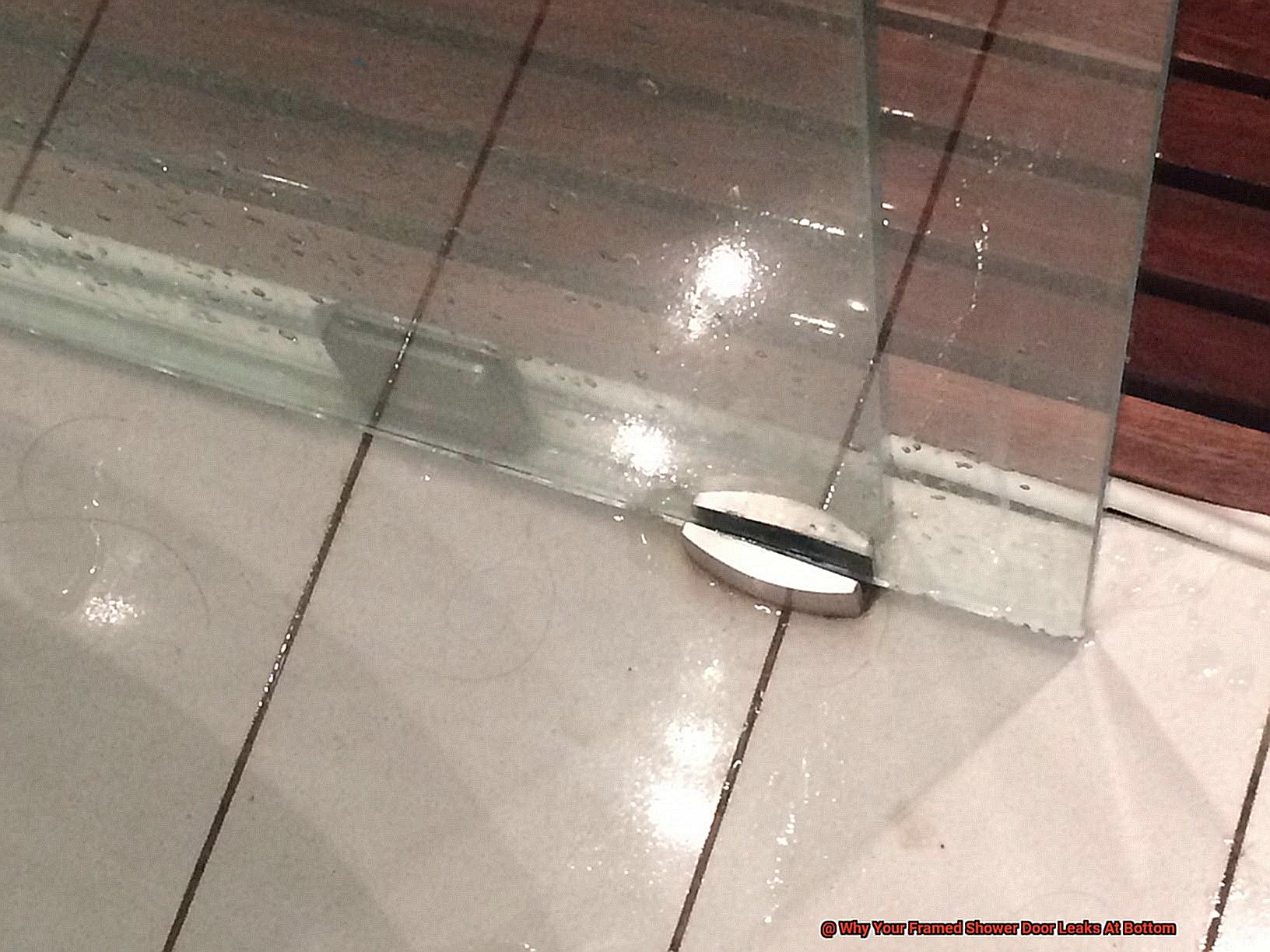
Make sure to rinse it off with warm water and dry it with a soft cloth or squeegee. Avoid using abrasive cleaners or sponges as they can scratch the surface of the glass or frame, making it more susceptible to leaks.
To protect the surface from water penetration or corrosion of the metal, apply a coat of protective wax or sealant after cleaning. Remember to follow the manufacturer’s instructions, and reapply every six months or as needed for optimal effectiveness.
Also, check the hinges and screws regularly to make sure they’re tight and secure, replacing any damaged parts promptly. Loose hinges can cause the door to sag or shift, leading to leaks or damage to either the frame or glass.
How to Repair Warped Frames on Your Framed Shower Door
Identifying Warped Frames: Warped frames on framed shower doors can lead to water leakage, resulting in costly repairs and mold growth. To determine the severity of the warping, remove the shower door from the frame and examine it closely. If the frame is slightly curved, it may be possible to bend it back into shape with gentle pressure. However, if the frame is badly damaged or cracked, you may need to replace it entirely.
Straightening Out Warped Frames
If your frame is just slightly curved, you may be able to straighten it out without replacing it. Start by using a heat gun to apply heat to the warped areas of the frame, and then use a pair of pliers or clamps to bend it back into shape. Work slowly and carefully until you get a satisfactory result.
Replacing Frames
If your frame is scratched or cracked, you will need to replace it completely for a secure fit and proper alignment. Make sure you buy a new frame that matches your existing shower door before installing it. Once installed, run water in the shower before reattaching the door for an extra layer of security against leaks.
Installing Leak Guards
Even if your frame is perfectly straight after repair or replacement, installing a leak guard strip along the bottom of your shower door will help prevent water from escaping at the bottom and encouraging mold growth in your bathroom. These guard strips are simple to fit and come in a variety of colors that can be cut as required for a precise fit on your shower door.
Preventing Future Damage
To ensure that your framed shower door remains leak-free in the future, we recommend regular inspection such as removing soap scum buildup and hard water stains regularly so that there is no interference between the door and its seal when closing it down.
How to Remove Hard Water Stains and Soap Scum Buildup from Your Shower Door
Fortunately, there are several ways to keep your shower door sparkling clean and free from buildup. Here are five tips to help you remove hard water stains and soap scum buildup from your shower door:
Vinegar and Water Solution
Create a mixture of equal parts white vinegar and water in a spray bottle, then spray the solution onto the affected areas of the door. Let it sit for a few minutes before wiping away with a cloth or sponge.
Baking Soda Paste
Make a paste out of three parts baking soda and one part water, then apply it to the stained areas with a cloth or sponge. Leave it on for a few minutes before scrubbing with a brush or sponge and rinsing off with water.
Commercial Cleaners
If the stains are particularly stubborn, try using a specially formulated cleaner designed for hard water and soap scum buildup, which can be found in most hardware stores. Be sure to follow the instructions carefully and use in an area with adequate ventilation.
Squeegee
To help prevent future buildup, consider wiping down your shower door with a squeegee after each use to remove excess water and stop mineral deposits from forming.
Regular Maintenance
The key to avoiding deep cleaning is regular maintenance of your shower door – after each use, wipe down the door with a towel or cloth to remove any excess water that could lead to buildup or staining later on down the line.
-jK1TQQkrpU” >
Conclusion
Water leakage at the bottom of your framed shower door can be caused by a variety of factors, such as poor workmanship, old seals, corroded metal frames, and loose hinges.
Fortunately, there are steps you can take to prevent and repair these issues. Installing a leak guard on the bottom edge of your shower door is an effective way to keep water out while also keeping your bathroom clean and free from mold growth.
Additionally, make sure to check the alignment of your door frame for a strong seal against water leakage. Use a heat gun and pliers to bend warped frames back into shape or replace them entirely with new ones that match your existing shower door.
A vinegar-and-water treatment or baking soda paste can be used to remove stubborn stains, but a squeegee should be used after each use to stop mineral deposits from forming in the first place.

